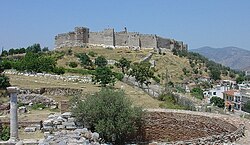Selçuk
Template: Infobox city in Turkey / Maintenance / County
Selçuk is a town and a district in western Turkey, in the province of Izmir, 75 km south of the provincial capital. The former name of the place was Ayasoluk. It is derived from the nickname of Hagios Theologos of the Apostle John. 1914 made under the Young Turks renamed Selçuk.
History
Selçuk is the successor of the ancient settlement Ephesus. A conquest by the Arabs 798 was short-lived, as the first occupation by the Seljuk Turks under Alp Arslan after the Battle of Manzikert 1071st This lasted only until the victory of the Crusaders in 1097 in Eskisehir. After the demise of the Rum Seljuk Turks took control of the region and Ayasoluk came to Beylik the Aydınoğulları. At that time, visited in 1333 the explorer Ibn Battuta the city. He reports on a prosperous trading town with flowering gardens and vineyards. The ruler Khizir Beg had contact with the Italian republics, there was a Genoese and Venetian consulate in the city. 1391 was the place under Bayezid II for the first time under Ottoman rule until he fell to the Aydınoğulları after his defeat by Timur. Under Murad II in 1425 he finally part of the Ottoman Empire and was from then on, chief town of a kaza ( district court ) of the Sanjak of Aydın. As in later times by the sediments of the Kaistros ( Küçük Menderes ) the port silted up more and more, the place lost its importance in favor of the port of Kuşadası.
Attractions
In Selçuk is the Archaeological Museum, where the finds from the excavations at nearby Ephesus exhibited. In some houses, ancient remains found because parts of Selçuk - İzmir and Kuşadası similar - were built from building material of Ephesus.
On the outskirts, there are the few remains of the Temple of Artemis at Ephesus, once one of the seven wonders of the ancient world. On the northeastern slope of Panayir Dagi is the dormouse cave of Ephesus, about seven kilometers away on the Bulbul Dagi one finds the House of Virgin Mary, the alleged death House of Virgin Mary.
In the city hill Ayasoluk was on the second millennium BC, the first settlement of Ephesus. In the seventh century AD the city was moved back because of the silting up of the harbor and the threat of the incident Arabs. At that time there was already the St. John's Church, one of the largest religious buildings of the Byzantine Empire. It was built in the 6th century by Emperor Justinian I over the supposed grave of John the Evangelist and remained until the 11th century intact, with its magnificent marble fittings. For the 110 m long, cruciform building and its six domes of the mountain was expanded to include an artificial terrace. On the upper plateau of the hill is the Byzantine- Seljuk citadel of Selcuk, probably also built in the 6th century.
The Isabey Mosque from the 14th century at the foot of Ayasoluk has a nice Stalaktitenportal, a peaceful courtyard and an atmospheric prayer hall. Nearby are the ruins of the Isabey hammam, a bath house is also from the second half of the 14th century.
In Çamlık, a district of Selcuk, a railway museum with a large collection of old steam locomotives.
About eight kilometers east of Selçuk is the completely preserved Greek-style village of Sirince.
Twin Cities
Siegburg ( Germany )









